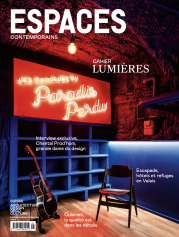ESPACES CONTEMPORAINS #DECEMBER 2022
DCUBE SWISS - DAVIDE OPPIZZI

WHAT ARE THE TYPES OF LED AVAILABLE ON THE MARKET?
For residential lighting, there are three types. On the one hand, individual bulbs using traditional old bases (type E27 or E14) which can sometimes be programmable. On the other hand, the all integrated lights - the LED and its printed circuit are in the body of the bulb. And finally, the LEDs in linear assembly, to illuminate cornices or details of furniture (stup LED).
WITH THE "ALL-INCLUSIVE" LIGHTS, HAVEN'T WE INVENTED THE DISPOSABLE LIGHT?
Programmed obsolescence in lighting dates back to the first electric bulbs whose filament was weakened to replace them more often... 20 years ago, LED manufacturers promised 100,000 hours of operation. Since 12-15 years, the guarantees have increased to 50,000 hours for professional lighting, from 15,000 to 25,000 hours for screw-in bulbs for the general public. The limited life of lamps often comes from the body of the luminaire which, if it is too small, has difficulty dissipating the heat projected by the LED towards the back. Without enough metal mass to act as a heat sink, there can be no powerful LED bulb. On the other hand, an LED is necessarily driven by an electronic system, which often lasts only 10,000 to 20,000 hours.
It has been developed universal ranges called "retrofit" which allow to extract the set LED-PCB-Aluminum. But they exist only for professional lighting.
WHAT NEW POSSIBILITIES HAVE LEDS OFFERED TO DESIGNERS?
There are many. But we can mention the development of nomadic lamps, which is only possible if they consume little. In this line of products, I designed the Curiosity lamp for Artemide that can be recharged with a USB cable. It can light up the terrace on summer evenings or be used indoors to enhance an object. And its consumption is very low (1,6 w).
CAN A DESIGNER ADDRESS THE ISSUE OF HEALTH THROUGH LIGHTING?
For a long time, the biggest concern of LEDs was their glare and their blue spectrum curve, which was too predominant in the photometry, destroying our natural clock by inhibiting melatonin and disrupting the circadian sleep-wake cycle. Today, the integration of multi-color diodes in the LED components, diffusing a warm and cold light, as well as the developments in programming, allow us to reproduce the sun's curve. In our studio, we are very active in hospitals where we create atmospheres that regulate the sleep cycle of patients and caregivers.
WHAT ABOUT CITY LIGHTING?
We work on all the issues of light pollution that are harmful to our environment when designing outdoor lighting. The Needo lamp for Artemide includes a filter that eliminates the blue spectrum, which further protects the plant and animal circadian cycle.
YOU HAVE DESIGNED SEVERAL HYBRID LUMINAIRES WITH DUAL FUNCTIONS. WHAT WERE YOUR OBJECTIVES?
The light must bring an added value to the product, be useful. In our design process we try to bring together two worlds, furniture and lighting, which sometimes have never met. This is the case, for example, with the Ametis shower for Graff, where the light therapy system really illuminates the shower area without any other light input..
WHAT CHARACTERIZES YOUR APPROACH TO LIGHTING?
For 21 years, we have defended the idea that "light reveals matter", in other words, that good lighting is often much more valuable than the finish of the luminaire itself. But our vision of light lies even more in what is now called "Human Centric Lighting", i.e. the art of mimicking natural light so that lighting promotes health, comfort and well-being.
Year ∙ 2022







